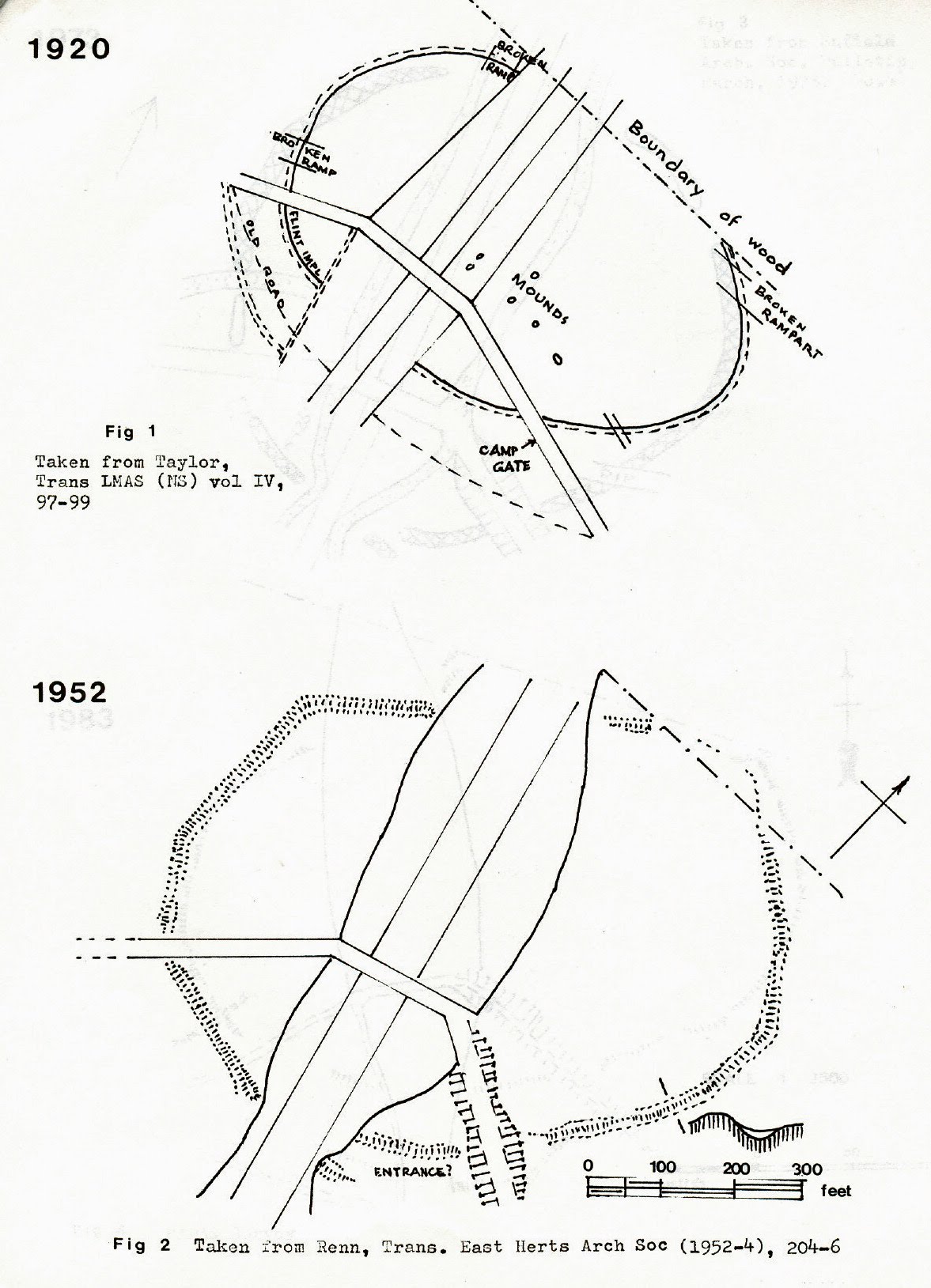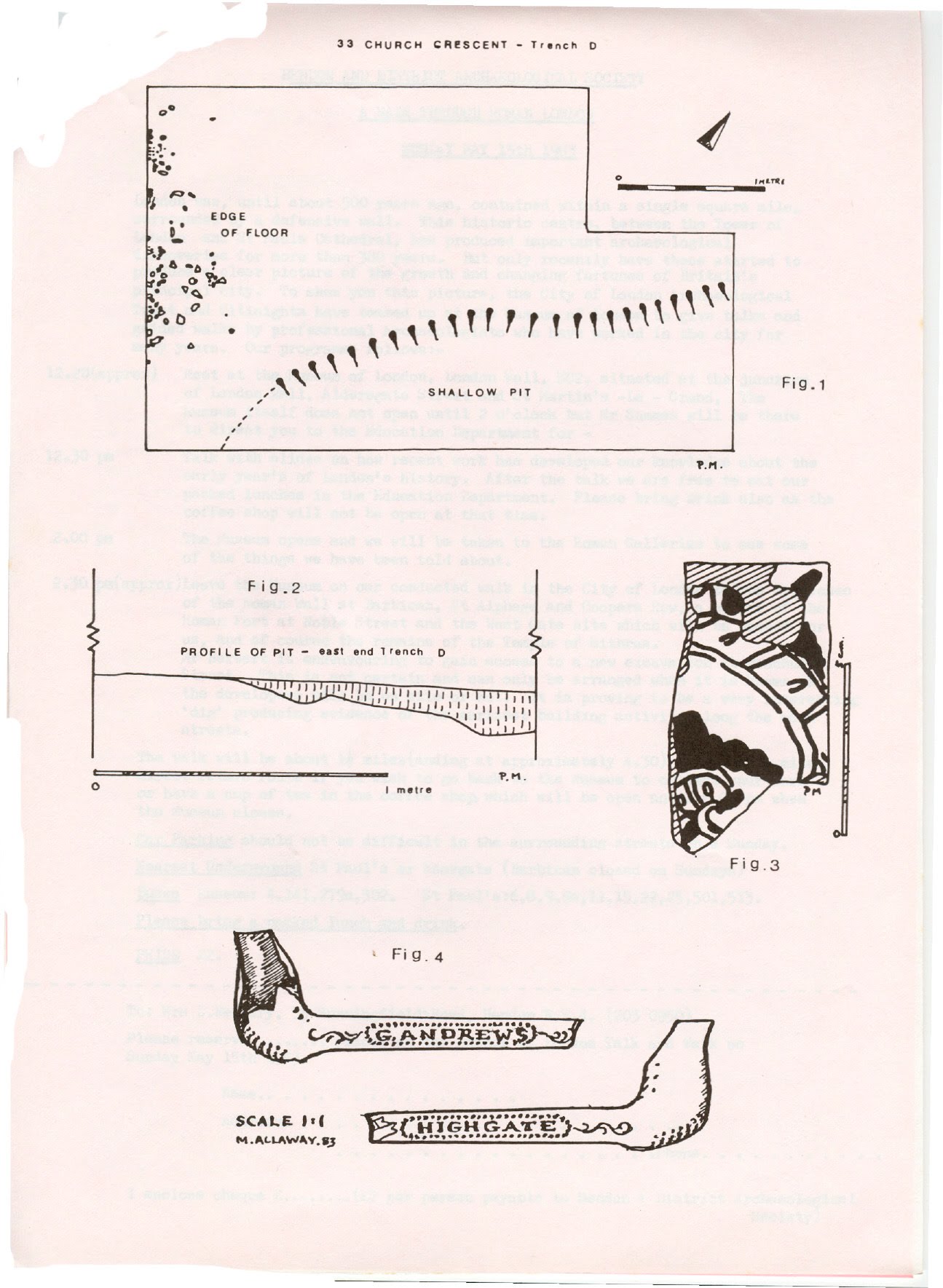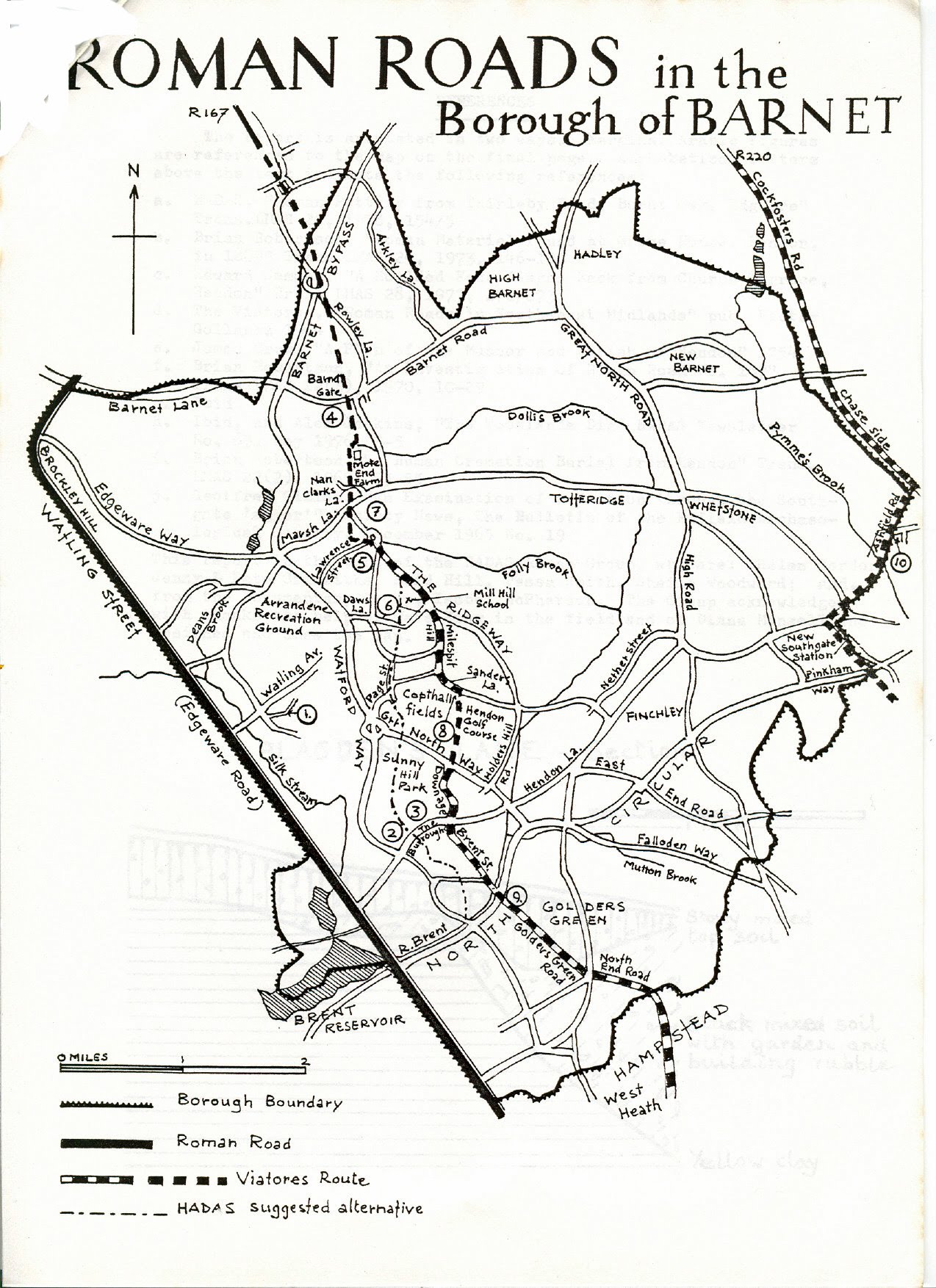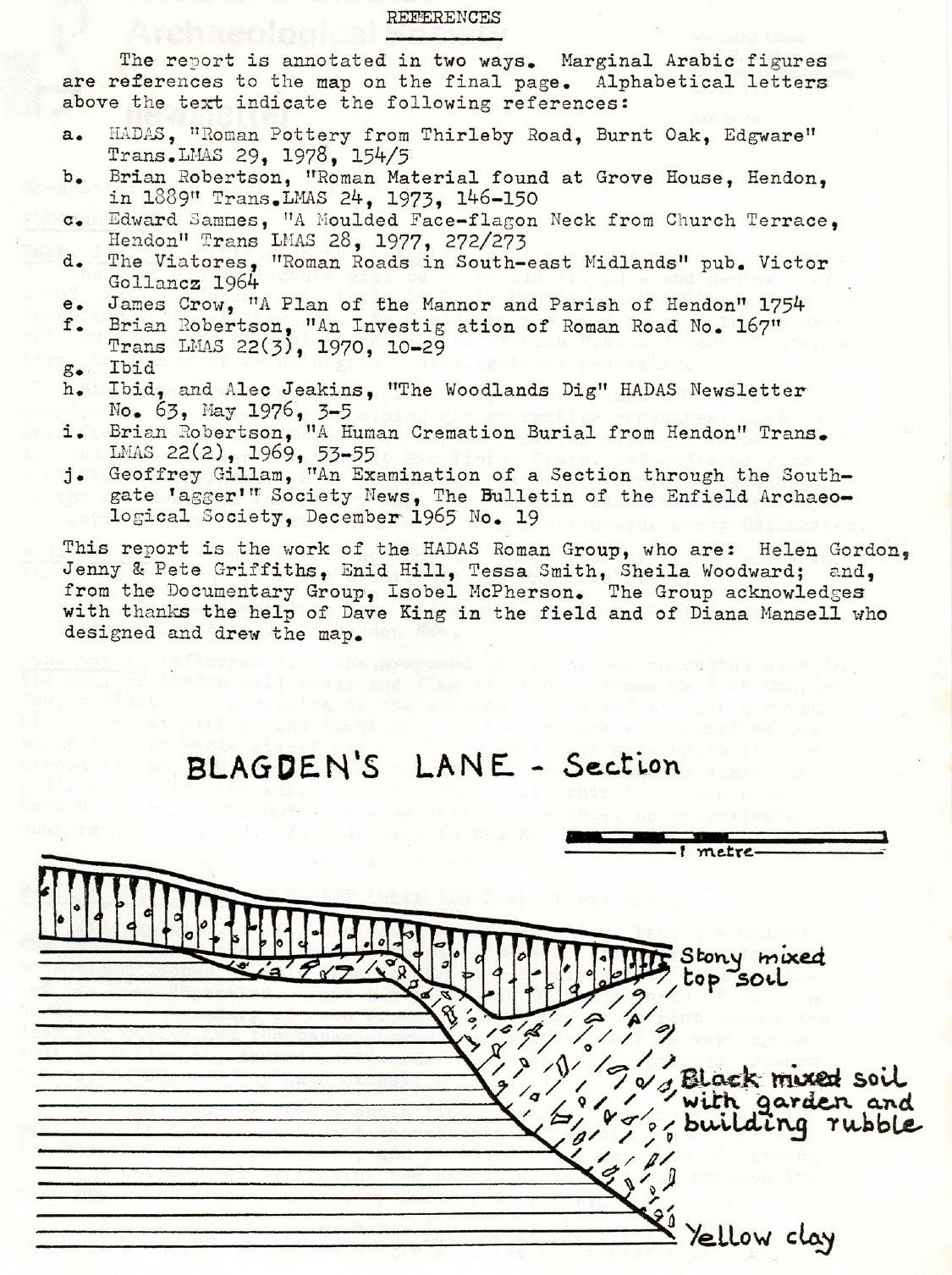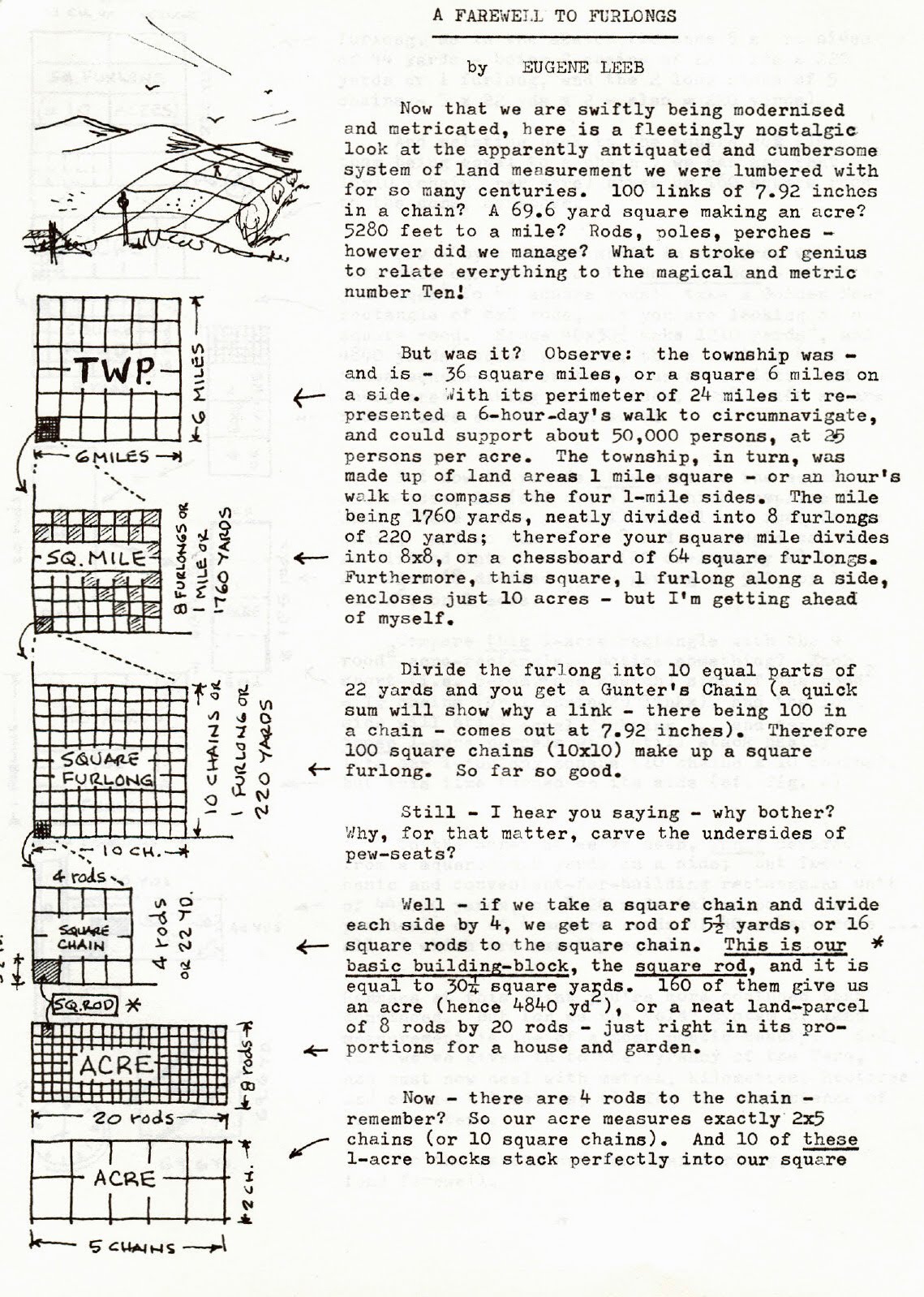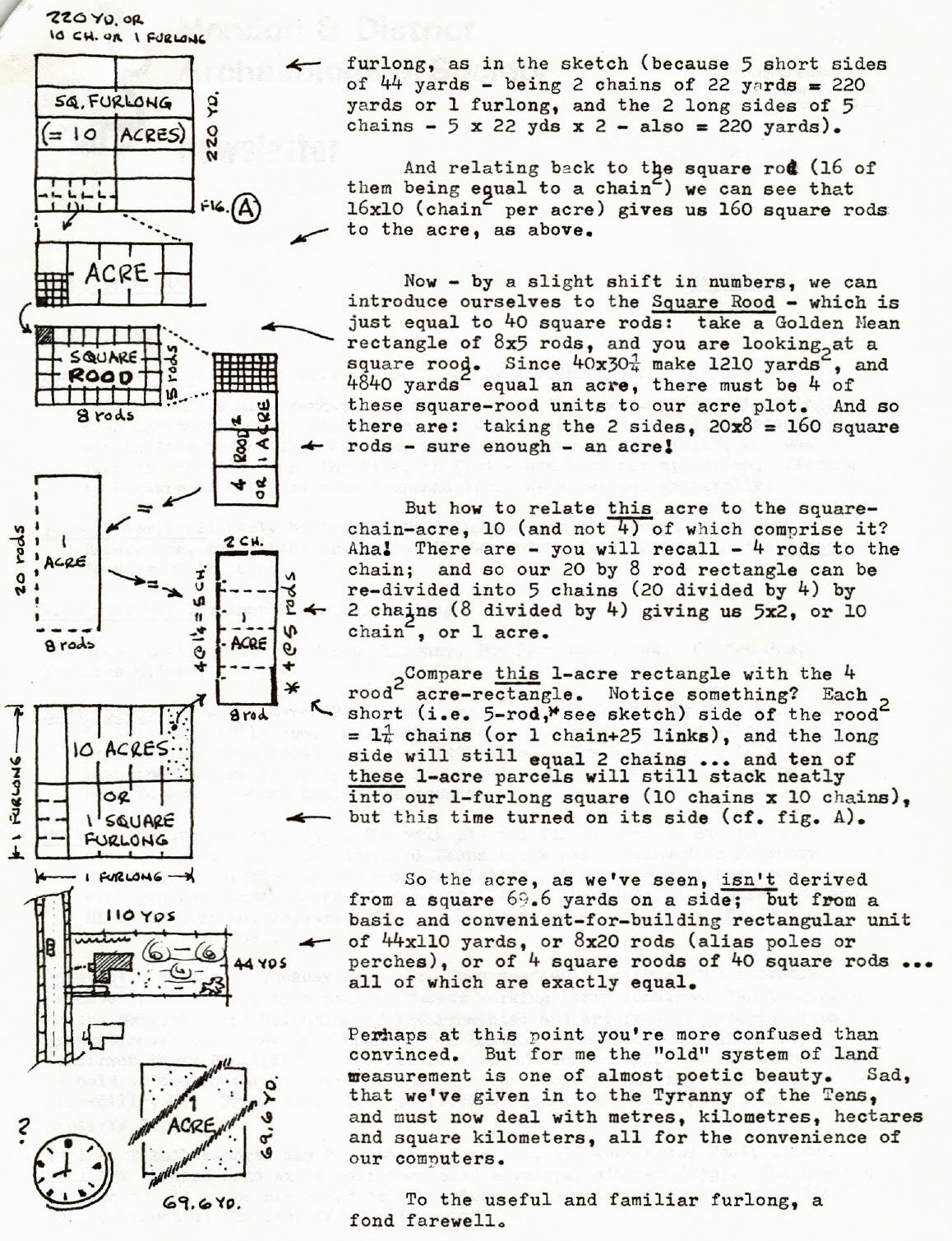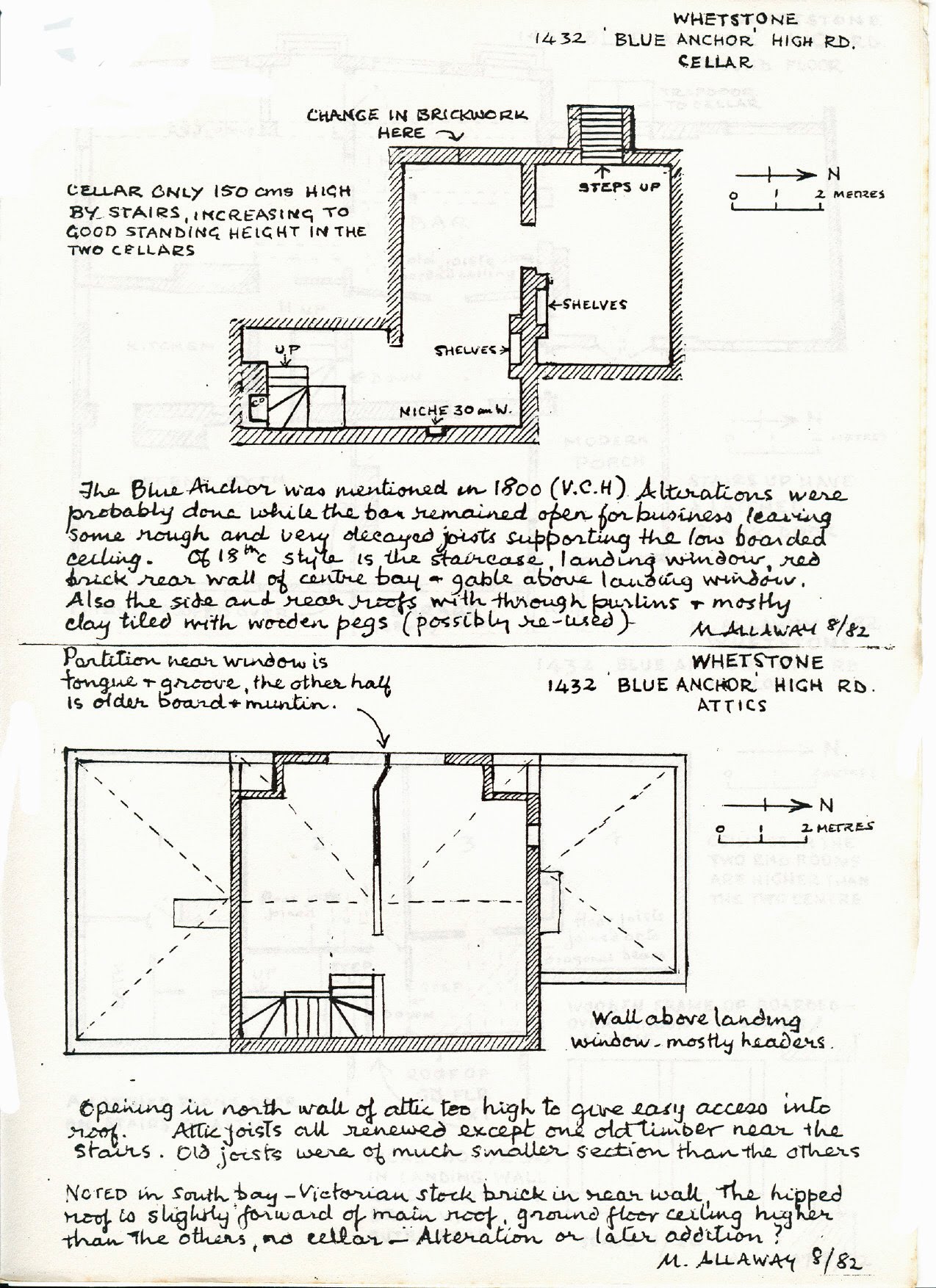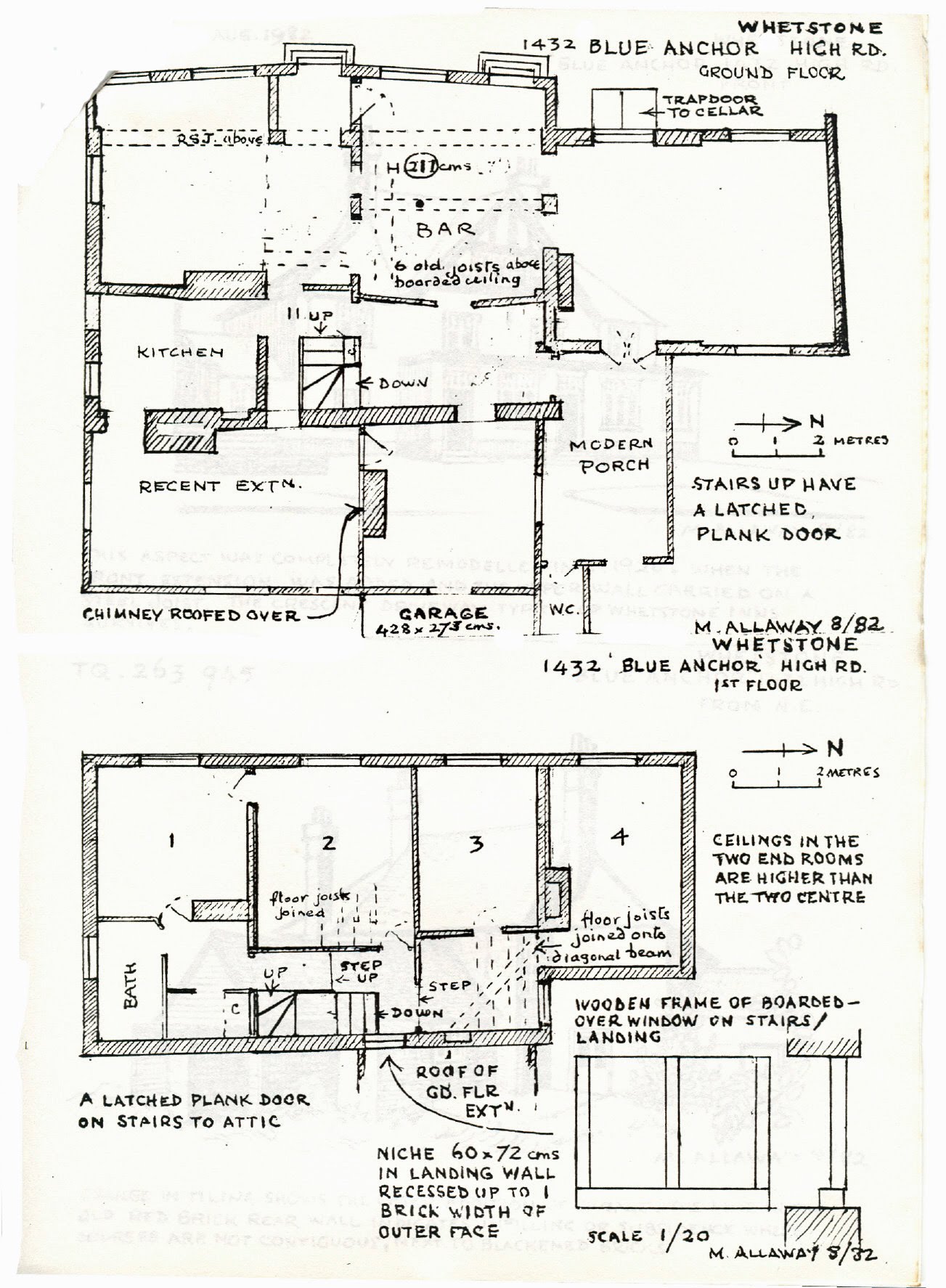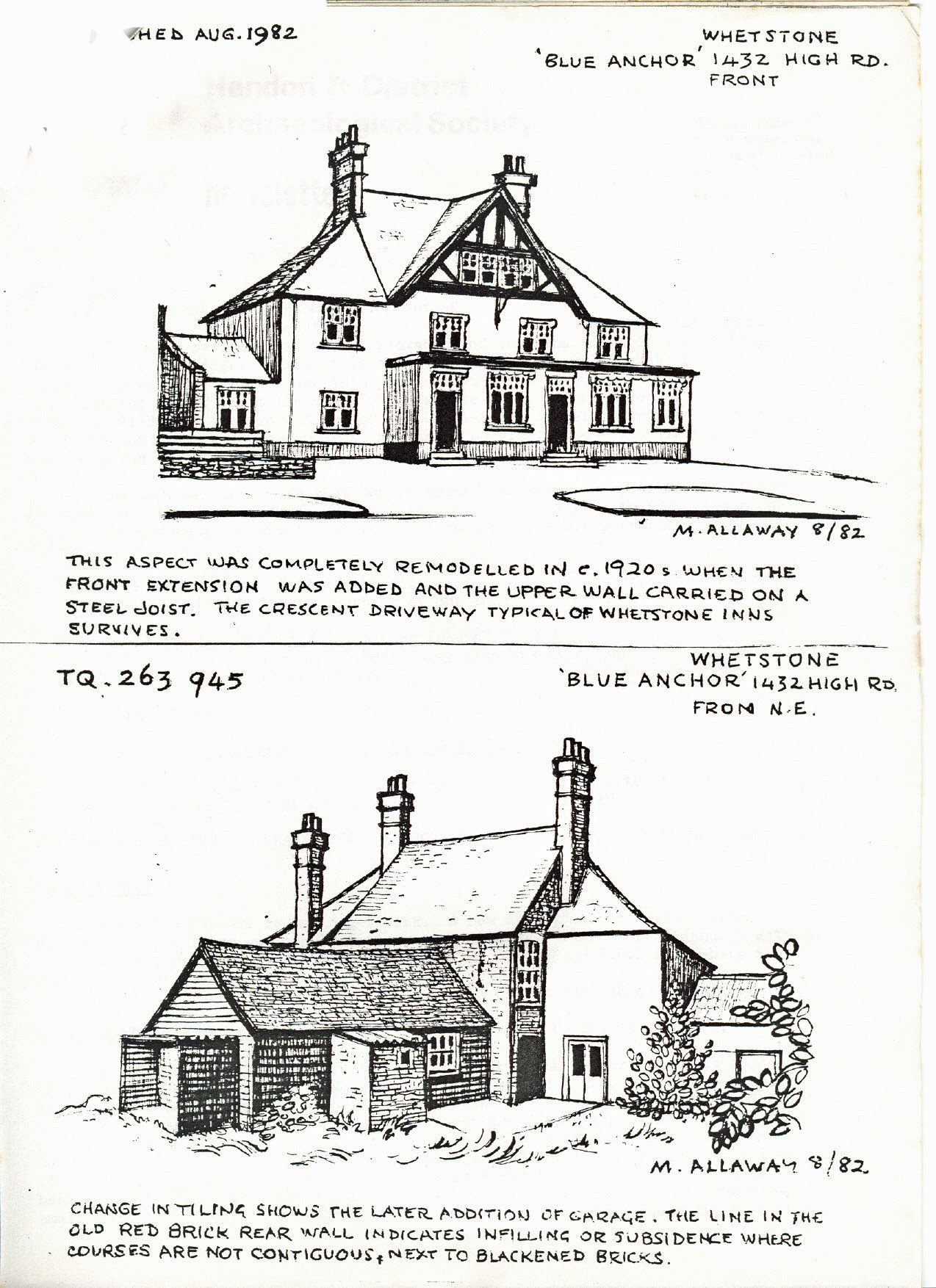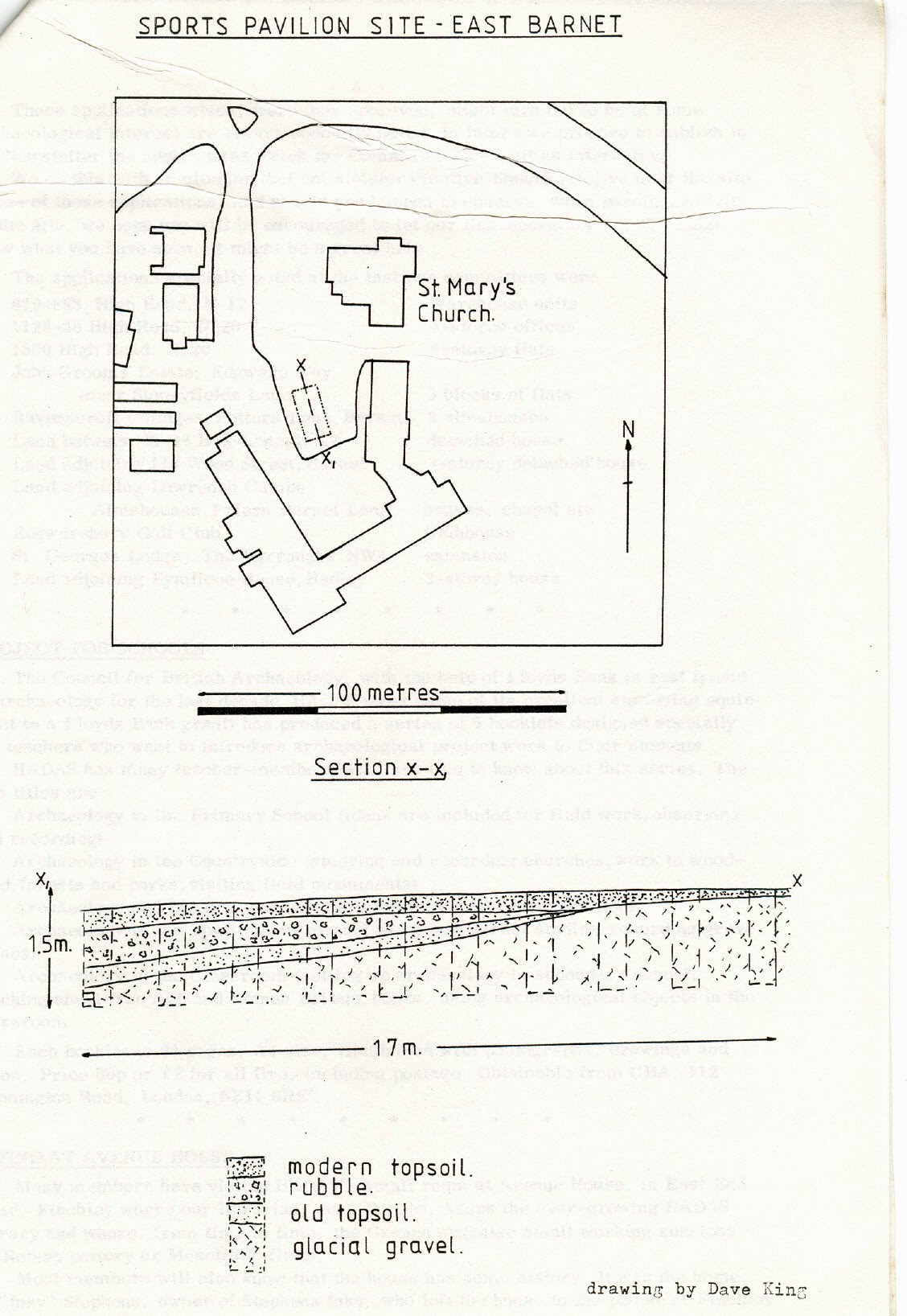NEWSLETTER NO. 153. NOVEMBER, 1983.
PROGRAMME NEWS.
Tuesday November 1st. Britons and Romans in Hertfordshire. Tony Rook.
Tony Rook from Welwyn is known to most of us, and well remembered for his lively lecture on Roman Bath Systems which he gave us in January, 1979. He is an extramural Lecturer in Archaeology for Cambridge and London Universities. He directed the Roman excavations in Welwyn from 1960 and was the chief instigator in saving the Baths under the Motorway which many of us may have visited. His most recent /dig’ is a huge boundary ditch in a rural area in which he has located a
Belgic farmstead, a Roman cemetary, a Bronze Age domestic site, a Roman tile factory, a late Norman-Early English chapel and settlements etc.,and a Belgic burial with a celtic mirror (now on display in the British Museum.) This exploration leads him to say in his letter – “I am fascinated by what happened as the Britons became the Romans in Britain, and what on (or in) earth happened to them after 410. I have
some outrageous ideas about this.” I am sure we shall learn what some of these ideas are on November 1st.
Sunday November 20th. Junior Members Roman walk in the City of London. 2;00 p.m. (Separate slip for Junior Members enclosed.)
Tuesday December 6th. Christmas Party. Dinner at Whitbread’s Brewery, Chiswell Street, and viewing of the Overlord Embroidery. A few places are still available for this outing – please apply to Dorothy -Newbury, 55, Sunningfields Road, N.W.4. (203-0950). Coach pick-up points will be circulated later.
PLEASE NOTE
THE LECTURE ON NOVEMBER 1ST ALL BE PRECEDED AT 8:P.M. BY A SPECIAL GENERAL MEETING (ALREADY NOTIFIED FORMALLY TO MEMBERS.)
Professor John Coles on Bronze Age Rock Carving in S. Scandinavia..
Reported by Ted Sammes.
Returning to speak to us after a period of 4 years, Professor John Coles held us spellbound as he addressed us on his work over the just eight years. This work had been aided by others and concerned the Bronze Age rock carvings of Scandinavia. These he said were to be found on large rock outcrops, many of which have been smoothed by glacial action as evidence by the score marks which they bear.
It would seem that prehistoric man preferred these sites in Norway, Sweden and Denmark. Within these countries there are many thousands of rock carvings of a variety of types. In some cases rocks which have an intrusive pattern of quartzite have been chosen, possibly .as decoration or to represent snakes. The size of such carvings varies considerably from a few inches to men larger than life.
The production of these patterns would have been accomplished by the use of successive blows with a hard hammer stone. An experiment had demonstrated that the production of a simple round Pup mark required the application of ten thousand blows of the stone to produce only a small’ symbol many of the rocks chosen have, nearby springs of Water.
The carvings ‘were first recognised in 1626, and much pioneer work was done in. the 19th Century. Finding the symbols produced some difficulties as the rocks are often covered with moss and lichens. Since that time, 1881, many more sites have been found, mainly due to the efforts of amateur Archaeologists each working in their own areas. Some of the earlier’ recorded ones have not been found probably due to forestry and other vegetation cover.
Recording the symbols once found is not easy but they can be made more readily visible by using very oblique lighting for photography, or by chalking in the outlines. The Swedish Antiquities Department are filling in the engravings with either red or white paint. Other Archaeologists are not allowed to carry out this technique!! Difficult .marks can sometimes be recorded using a brass-rubbing technique Very good results have been obtained by using fresh grass as a rubber.
In taking drawings and sections the use of a type of depth comb is a great aid to securing the profile.
In some areas tall Bronze Age barrows exist’ and the burials when they occur in wet conditions are found in wooden coffins with weapons and jewellery for the after life. Many such burials also have well preserved clothing. During this period there is no trace of local mining of lead, copper, tin or silver. These were 11 obtained over long distances by trade, probably by exchanging amber which wars plentiful in Scandinavia.
Returning to a discussion of the symbols he said that these covered many types of animals, cattle and oxen. -Sometimes these were harnessed to an and or plough. Chariots and, boats were found, there human figures are depicted they had no faces or eyes, and mostly they are male and phallic. “Foot-sole” marks looking like shoe marks are also found and these usually point towards water. At that time the water level of the sea would have been higher than it is to-day. There are hunting scenes, and flotillas of boats houses, children and sheep are not represented.
Professor Coles concluded by discussing the changes in the relative heights of land and sea and the climatic conditions which would have put most of these carvings near the water’s edge in the Bronze Age. He believed that the designs, most of which were probably executed during the period 1700 – 1500 B.C, could have taken many years to produce.
RECORD BREAKING MINIMART.
Brigid Grafton Green.
This year’s Minimart, held on familiar ground at St. Mary’s Church Hall, Hendon, on October 15th, was a record breaker. At the time of going to press the net total takings top £650. They are still climbing, Dorothy Newbury thinks. The highest figure we have made before – in February, 1981 was £565.
When we first held a Minimart in March 1974 we rejoiced mightily at making £115. This Year is the eighth since then (we’ve missed only one year, 1980) and perhaps someone less ham-handed at figures that I am can work out whether £650 in 1983 keeps pace with, or betters, inflation since 1974.
We’ve been asked to thank everyone who combined to make this such a success – the providers of goods, without whose generosity we would have had nothing to sell; the sellers and the setter-uppers who worked like demons on the day; the buyers, who either liked or didn’t count the cost; and, above all, the two Queen-pins, Dorothy Newbury and Christine Arnott, who organised the whole thing and lived with it for, the best part of six weeks beforehand.
As always, everyone will carry away from Minimart ’83 memories of some unforgettable moments. I have two. One is the astonished face of one of our tougher male diggers who was approached by a small boy of three who handed him something saying politely “I think this is your handbag.” The other is the equally
staggered look on our Hon. Treasurer’s countenance when informed that a bag of French bread, uneaten during the ploughman’s lunch, had been left because it was thought he might like to give it to the horses at College Farm. “But I don’t know the horses at College Farm,” he objected, in shattered accents.
NEWS FROM THE GROUPS.
Documentary Group. This month JEREMY CLYNES provides a note on:-
THE DROVERS.
The Snowdonia National Park Study Centre, which H.A.D.A.S., Members know well, recently ran a course on Drovers and Drove Roads of North Wales. It was led by a member of the Centre Staff, Tomos Elias, who has done a great deal of research on the subject. —
What was surprising was the number of times the names Barnet and Edgware turned up in the documents he was studying, these being prime destinations for drovers with sheep or cattle on the hoof.
At least from the time of the Norman Conquest to the establishment of the railways the most important long distance travelers were drovers, who took sheep — and cattle reared in the remotest areas of England, Scotland and dales to chose parts of the country that consumed the meat – of which London was one of the largest consumers. They sold their beasts at venues such as Barnet Fair to local farmers who would fatten the cattle and then resell them at Smithfield for slaughter.
The drovers and the cattle they brought must have been of great economic importance to our Borough for centuries, yet little research has been done on this so far. Also what was Barnet Fair like? It sounds great fun, from the following extract from the Daily News of 1850:
“A Welsh drover fell among the thimble-riggers at Barnet fair, end was considerably fleeced. He, however, had his revenge in the following fashion. Quitting the town with his drove, he espied ore of his plunderers in the road; with the assistance of a brother drover or two, he made capture of him, fastened him Mazeppa-like astride one of their wildest unbroken colts, started the animal off at a rough trot, and after a ride of four or five miles the fellow,
galled, jaded and three parts dead, was glad to purchase his release from further torment by disgorging his illgotten pelf.”
*NOTE: welsh drovers brought unbroken horses and ponies to the Horse Fair at Barnet; and also cattle – cows, heifers and steers – to the Cattle Fair, held near the Horse Fair but closer in to the town.
We hope to carry in a later Newsletter a more detailed article from Tomos Elias himself on the Welsh end of the story. We would also like to persuade one or more H.A.D.A.S., Members to follow this fascinating topic of study up from the Barnet end. Any volunteers to help in this project will be warmly welcomed – please let Brigid Grafton Green know if you would like to take part, on 455 9040 or at 88, Temple Fortune Lane NW.11.
For new Members who may like to know more about the Snowdonia National Park Study Centre, the Centre is run by the National Park Authority. It organises courses on all aspects of the National Park, including Archaeology. In the next few months there will
be:-
November 11-14 Neolithic Wales.
January 13-16 Bronze Age Burial Ritual.
February 24-27 Prehistoric Settlements.
March 17-23 Introduction to Industrial Archaeology
” Archaeology of Snowdonia
March 23-26 Early Iron Industry in North Wales,-
More information obtainable from:-. The Principal, Plas Tan y Bwich, Maentwrog, Blaenau Ffestiniog, Gwynedd LL41 3YJ (Phone 076685 324).
Documentary researchers may like advance warning (because it’s likely to get overbooked) of a one-day course being organised by the British Association for Local history on -April 27th next. It consists of a guided tour round the two parts of the Public Record Office starting at Kew at 9:45 p.m. and ending Chancery Lane at 5:p.m. Types-.
of records and the mechanics of P.R.O. research will be discussed. Cost £3 to BALM. Members -£5 non-Members… Apply to BALH,-43, Bedford Square, WC.1.B.3DP.
ROMAN GROUP.
Don’t forget the working potter ‘weekend on November 12/13th. For details, see October News Letter.
PREHISTORIC GROUP..
14 Members of the group met on the 18th October to discuss future plans. These include:-
Surveying. 2 evening lectures on surveying to be given by 1,1r. Lampert, probably during November to be followed by a practical exercise t Moat Mount. Any Members interested should telephone Audrey Hooson, 445-4437.
Stream Walking. ‘Walking of the Silkstream and Dean’s Brook has been completed and it is now proposed to follow the course of the Dollis Brook from South to North. The
initial walk will probably take place early in December. Any Members interested should telephone Sheila Woodward, 952-3897.
Dig at West Heath. .A new season of excavation of the Mesolithic Site on Hampstead Heath will open in June, 1984 and will continue for a period of 6 weeks. Further information will be given in the December Newsletter. Meantime, any Members wanting
further details should telephone Margaret Maher, 907-0333, or Sheila Woodward, 952-3897.
SITES TO WATCH
Among recent applications for Planning Permission; on sites which might be of some Archaeological interest if development were to be approved, are the following:-
Hand and Flower public house, Whetstone Office block.
Bald-faced Stag public house, East Finchley ditto.
Old Fold Golf Club, Hadley single-storey Artisans clubhouse.
Any Member who notices activity (which, in the first two instances, would start with demolition) is asked to let Elizabeth Sanderson know on 950-3106.
LONDON AND MILITARY CONFLICT, is the subject of the 18th Local History Conference (mentioned briefly in the September Newsletter) which is being organised by the London & Middlesex Archaeological Society on November 19th at the ,Museum of London.
There will be four main lectures: London in the Blitz; victualling the Navy from Deptford; London barracks; and London in the Civil War. There will also be a wealth of displays of their work by local societies and all the latest local publications will be on sale. Offers of help on the H.A.D.A.S., stall will be most welcome. (Ring Brigid Grafton Green on 455-9040 if you would like to help).
SOMETHING FOR YOUR CHRISTMAS STOCKING?
Latest books for Shire include Ancient Boats (51.95) by Sean McGrail of tine National Maritime Museum; and Discovering Roman Britain (£2,50) edited by David Johnston of Southampton University.
The latter, in gazetteer form with six introductory chapters by the Editor, is of particular interest to H.A:D.A.S., as one of the six gazetteer contributors is Vice-President Ted Sammes. He is responsible for the entries for Hampshire, Isle of Wight, Kent, Greater London, Surrey and Sussex.
Copies of these books – and either would make a nice small Christmas present -are obtainable from Pete Griffiths, .8, Jubilee Avenue, London Colne, Herts, AL2.IQG.
MORE ABOUT ARCHAEOLOGY IN GREATER LONDON.
Members will recall that in the June Newsletter TED SAMMES wrote about the now London Archaeological Service which started on April 1st last, funded by the GLC and under the control of the Museum of London. KATE BALEN, Junior Representative of H.A.D.A,S. Committee, attended a meeting in September at the Museum to discuss the new service. She provided a detailed report for the Committee, and here are some of the points which she made in that report:-
About 50 people attended the meeting, from the staff of the Museum, from the professional archaeological units in London and from local societies. HADAS was represented by Victor Jones, Paddy Musgrove, Brian Wrigley and myself.
The present archaeological situation in Greater London was described, and hopes for the future were outlined. Harvey Sheldon, Archaeological Officer to the Museum of London, explained the desirability of getting some kind of coherence of effort among the different groups and units who work in the area; and of starting to cover those parts of Greater London in which no unit or local society exists. He also underlined the need for some kind of even distribution throughout the area of the funds which are available. The service, he thought, should provide economical ways of publishing excavation reports and also prevent backlogs of unpublished information accumulating. Better conservation of finds, and improved photographic and archive facilities are also on the agenda.
The GLC’s initial grant of £250,000 will be spent on staffing the new service with 25 permanent professionals. Funds from the Department of Environment will cover equipment, short-time staff, rates and rents. Local societies which already receive grants for their work were urged to continue to press for them from their local authority.
In the discussion which followed Mr. Sheldon’s exposition, the present precarious position of the GLC was immediately raised. The Museum authorities are, however, quite certain that now this service has been established, it will be very difficult for anyone to get rid of it, even if or when the GLC is dismantled. The storage of archives and finds was discussed. It was quite clear that local societies wished those to be kept
in local areas, but this point may not have been accepted by Museum officials.
There was a strong call for co-operation between professional Archaeologists and local societies regular meetings between the two at local level are planned, and more occasional general meetings will take place between the Museum and local societies.
TRYING IT ON.
About a year ago the Newsletter reviewed the third issue of the Bulletin of Experimental Archaeology, produced each year by the Department of Adult Education at Southampton University. Now the fourth issue has surfaced. This excellent publication deals with different experiments going on all over the world. It is something of a lucky dip – wherever you put in your thumb, you pull out a plum.
Here are one or two items from the present issue, reprinted by kind permission of the Editor of the Bulletin, David Johnston:
The Fracture of Flint Arrowheads,
Three or four years ago Dr. Mark Newcomer of the Institute of Archaeology, London, carried out tests to measure the effectiveness of prehistoric flint arrowheads and to study the way they broke on impact. The Bulletin reports as follows on these experiments.
“Replicas included leaf-shaped points, microlithic arrowheads and wooden arrow tips barbed with flint microliths. These points were fixed to wooden arrow-shafts with an adhesive compound of pine resin and beeswax. The target was composed of layers of meat covering an arrangement of bones. To ensure consistency of aim and force, a replica mesolithic bow with a draw-weight of 21 kg was used in preference to throwing or to the use of a spear-thrower. The range was about 3m.
All the arrowheads penetrated deeply and caused extensive damage to the muscular tissues. The shattering of the flint on hitting the bones often proved identical to the fragmentary points sometimes excavated in association with animal bones; this suggested that many such broken points had been carried back to camp in the carcasses.”
Source: Dr. M.H. Newcomer. .
Institute of Archaeology,
31-34, Gordon Square, W.C.1.
Flint Debitage Analysis.
A study is currently taking place in British Columbia of 38 flint assemblages from 4 regions, mainly from settlement sites: winter pit-houses, cachepit sites, open-air habitation sites, large mammal processing sites and miscellaneous lithic scatters. The Bulletin reports:
“One of the most important findings is that weight of individual flakes is not a good predictor of reduction stages when several tool forms arc replicated. Instead, dorsal face and platform scar counts are highly accurate predictors of early middle and late reduction stages. Crucial to the identification of stages is the recognition of two major flake classes, that is, flakes that are platform remnant bearing (PRB) and those without platforms (shatter). Not only does the relative frequency of shatter flakes decline as reduction proceeds, but also the dorsal flake scar count of shatter flakes is as accurate a predictor of stages as the platform scar counts of PRBs.
The result of the experimental program is the ability to analyse complete samples of debitage by means of a stage classification that uses platform and dorsal scar counts as criteria. This information is related to similar data on tools and cores with the aim of producing a series of measures of assemblage variability with respect to task expediency, row material conservation, tool duration and other middle range concerns in lithic technology.”
Source: Martin Magne, Archaeological Laboratory, Dept. of Anthropology and Sociology, University of British Columbia, Vancouver, BC.
Some of the other subjects covered in this issue of the Bulletin (which is obtainable from the Department of Adult Education, University of Southampton, price £1.50) are the use of antler and bone tools for fluting Folsom points; producing and measuring use-polish on flint hoes; comparing the efficiency of flint and ground-stone axes; the Bronze Age use of rope-traction ands for ploughing; the moving of heavy capstones for megalithic tombs; how vitrification was produced within timber-laced ramparts; and methods of shale-working in Roman Britain.
One article describes an attempt by a group of six Archaeologists to live for a week as a hunter-gatherer group on a remote lake-shore in Sweden. They ate berries, fungi, lichens, fish and a butchered reindeer, but cheated a bit by supplementing their diet with modern bread, cheese and apples. Their activities included fishing with home-made rods and lines; skinning and butchering the reindeer and preparing the skin; cooking and smoking their food; stripping and using birchbark and knapping and working various stones.
It is interesting that they found they had so much to learn just to keep alive that they had no time for any controlled experiments. The Bulletin sums it up “For that, a group greatly experienced in life in such setting would be necessary,” and ends “although the possibilities of finding similar areas capable of supporting such work in Britain are limited, experiments like this are most useful.”
anyone got any ideas for where, or how, H.A.D.A.S., could conduct such an experiment in the London Borough of Barnet?
Sixty years of the Edgware Extension.
by Bill Firth.
In 1967 London Transport published a booklet “Sixty Years of the Northern” to commemorate the diamond jubilee of the opening of the tube from the Strand (now Charing Cross) to Golders Green and Highgate (now Archway). On the 19th November, 1923 the extension of the line from Solders Green to Hendon Central was opened and on the 18th August, 1924 it was opened right through to Edgware. This is, therefore, the time to commemorate sixty years of the Edgware extension.
In 1902 an extension of the line from Hampstead to Golders Green was sanctioned. At the same time the Edgware and Hampstead Railway Company was incorporated to continue the line to Edgware. In 1903 the Watford & Edgware Railway Company was
formed to build a six mile extension from Edgware to Watford. (This line, or something like it, was planned to come into operation in December 1940 but world War iI stopped it – however, that is another story).
The original Company had by now become part of the Underground Electric Railways Company of London Ltd., more generally called the Underground, which absorbed the authorised but deferred extensions and when World War I was aver, started to proceed with the work. Construction started on the Solders Green – Hendon Central section on the 12th June, 1922 when the first sod was cut near Highfield Avenue and 17 months sufficed to see this completed. The Hendon-Edgware section was
not started until November 1922 and was not ready until August 1924 because of the time required to build the Burroughs tunnel North of Hendon Central. On opening day the stations at Colindale and Edgware were not fully completed and Burnt Oak could not be opened until October because of a strike of builders.
From Solders Green the line is built on brick arches or in embankments with
brick retaining walls with brick arch or metal span bridges as far as the North West
side of the Brent Valley. In the early days of railways this stretch would have been an engineering wonder but by the 1920’s such efforts had become commonplace. The line crosses a number of roads and Montpelier Rise, where the road and rail levels are much the same, is actually split into two parts by the railway.
At Brent Station (originally to have been Woodstock and now of course Brent Cross) passing loops were installed to cater for a short lived non-stop train experiment.
The space for the extra-lines is clearly visible from the station platforms and there are two bridges over Highfield Avenue, originally to take four tracks.
The Burroughs tunnel, over half mile long, was built in the same way as the tube tunnels under London and is the main engineering work on the rest of the line which otherwise runs in shallow cuttings or on low embankments.
The stations were designed by the Underground Group’s Architect, S.A.Heaps, and were styled to match the (then) rural surroundings. The front elevation was a Doric collonaded portico and the buildings were designed to take an extension on top, as at Hendon Central. The entrance at Colindale was extensively damaged in an air raid
in World War II and is a modern rebuilding (I don’t think Mr. Heaps nor Mr. Holden, who designed so many tube stations in the 1930’s, would have approved).
At Edgware the possibility of extension to Watford was remembered and the shops and flats on Station Road were built on a raft to facilitate tunnelling through at
a later date.
The main station buildings at Edgware were symmetrical with a range of small shop buildings on the north side to balance the open bus waiting room on the South.. The former range was demolished in 1939 in connection with the works for the not-tobe-completed extension to Bushey Heath. There is an interesting series of pictures, one of the yard, taken over a number of years showing originally a bus turning circle
and a large raised rose bed – as bus traffic increased the rose bed got smaller until inevitably it disappeared altogether.
When opened, Edgware Station had only an island platform with two faces like the other stations. The new, present platform I was built in connection with the proposed extension.
In the early days the Underground group was not happy with the slow build-up of traffic because of the slow residential build-up of Edgware (fast as it may hove become later) and through its associate, the London General Omnibus Company, a number of feeder bus routes were operated with cheap and, in some cases, through road-rail fares. Even the opening of the Metropolitan Railway’s Stanmore branch in 1932 did not stem the tide of commuters from around Cannons Park because until 1939 the Metropolitan’s fares were much higher. Ironically in 1937 there was an outcry at the inadequacy of the tube service and one palliative measure was the operation of nine-car trains – some platforms were lengthened fort his but at the underground stations special arrangements were necessary. (If all the proposed 1938 Northern line extensions had gone ahead none-car trains would have become more common).
To cater for the buses a garage was built at Edgware in 1925 but was rebuilt on a new site in 1939 because the original site was required in connection with the
proposed tube extensions. The other major railway building around the station is the carriage sheds on the North side. -.
Following the extensions at the South end of the line and the integration of the City Branch, with the flying junctions at Camden Town, a problem over the name of the system developed. There were various trials with such names as Edgware, Highgate & Morden, and Morden-Edgware (not popular with Highgate Branch residents) before Northern Lino was adopted in August 1937.
Lastly there are one or two minor features to be noted. When the railway was built, wooden distance posts (from Charing Cross) and gradient posts were installed. Good examples can be seen from the North end of the platform at Brent Cross and at Hendon Central and Colindale. There are also three stylistically interesting “Trespassers will be Prosecuted” notices inside the railway boundary alongside the footpath in Colindale Park.
Sources:
The three main sources for the above are:
Lee, Charles E., Sixty Years of the Northern, London Transport, 1967.
Hardy, Brian, The Northern Line Extension, Underground,9? 1981. (The journal of the London Underground Railway Society).
Jackson, Alan A:, Semi-detached London, George Allen & Unwin Ltd., 1973. STOP PRESS.
A new course at The Polytechnic of North London Post Graduate (part-time) Diploma in Planning for Conservation in Britain.
A Course concerned with key issues and modes of involvement in ‘Planning the conservation of the man-modified environment.
Fee details and application forms on request from The Polytechnic of North
London, Department of Geograply and Geology, The Marlborough Building, 383, Holloway Road, London N.7. Telephone: 01-607-2789. Course starts January, 1984.
Palestine Exploration Fund illustrated lectures at The Society of Antiquaries, Burlington House, Piccadilly, W.1.
Monday 24th October at 5:30 p.m. The Anglican Bishopric in Jerusalem – An Historical Survey by Mr. Patrick Irwin.
Monday 14th November at 5:30 p.m. Early Photographers in the collection of the Palestine Exploration Fund.
Monday 5th December at 5:30 p.m. At the Linnean Society, Burlington House -A Zoological Expedition to the Negev. Mr. L. A. Heizler and Dr. Philippa Moss.
Admission to all Lectures free without tickets.
Two Thursday evening Lectures, December 1st & 8th at 7.p.m. at The Institute of Archaeology, Gordon Square, by Dr. Soren Andersen, Director of Prehistoric Archaeology, University of Aorhus, Denmark.
December 1st: Recent excavations at Tybrind Vig and the Ertobolle culture. December 8th: New light on the origins of Agriculture in Scandinavia.
Tickets (i2) from Miss Edna Clancy, Room 255, Department of Extra-Mural Studies, 26, Russell Square. W. C. 1.

